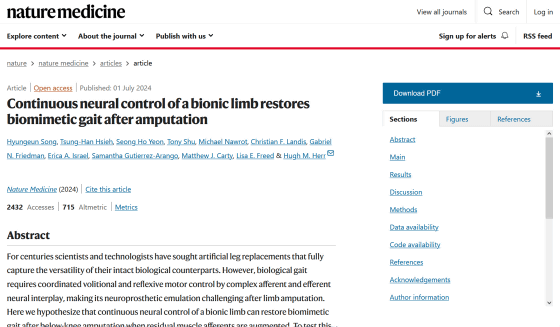By combining special surgical procedures with 'prosthetic limbs that can be connected to the patient's nervous system,' people who have lost a leg can walk naturally.

For people who have lost a leg due to an accident or illness, a prosthetic leg that allows them to stand and walk naturally is an important factor in determining the quality of their life. A research team at Massachusetts Institute of Technology (MIT) has reported that by combining a special surgical procedure with a prosthetic leg that can be controlled by the patient's own nervous system and can also provide neurofeedback, patients are now able to walk more naturally than with a conventional prosthetic leg.
Continuous neural control of a bionic limb restores biomimetic gait after amputation | Nature Medicine

A prosthesis driven by the nervous system helps people with amputation walk naturally | MIT News | Massachusetts Institute of Technology
https://news.mit.edu/2024/prosthesis-helps-people-with-amputation-walk-naturally-0701
Bionic legs plugged directly into nervous system enable unprecedented 'level of brain control' | Live Science
https://www.livescience.com/health/surgery/bionic-legs-plugged-directly-into-nervous-system-enable-unprecedented-level-of-brain-control
At the time of writing, state-of-the-art prosthetic limbs allow amputees to walk fairly naturally, but they cannot be controlled by the nervous system in the same way as real legs. Instead, they rely on robotic sensors and controllers that move the legs using predefined walking algorithms.
Limb movements are controlled by the alternating contraction and extension of the ' agonist' muscle, which is the main muscle that moves, and the ' antagonist' muscle , which moves in the opposite direction. However, in patients with amputations, the interaction between these pairs of muscles is interrupted, making it difficult for the nervous system to obtain sensory information such as muscle position and contraction speed, making it difficult to control prosthetic limbs.
To solve this problem, a team of MIT researchers, in collaboration with researchers at Brigham and Women's Hospital, developed a surgical procedure called an agonist-antagonist myoneural interface (AMI), which connects the tips of agonist and antagonist muscles in an amputated limb, allowing dynamic communication within the remaining limb.
A 2021 study found that patients who underwent AMI had more precise muscle control, experienced less muscle atrophy, and experienced less pain in the affected area than those who underwent standard procedures, and that their remaining muscles produced electrical signals similar to those in intact limbs.
The researchers wondered if the electrical feedback seen in patients with AMI could be used to control a prosthetic limb that can be connected to the nervous system. In the new experiment, 14 subjects, seven of whom had had AMI and seven who had had traditional below-knee amputations, were asked to walk using a prosthetic limb that was powered at the ankle and equipped with electrodes that picked up electromyographic signals from the shin and calf muscles.
You can see an actual subject who had an AMI going up and down stairs using a prosthetic leg in the video below.
Helping people with amputation walk naturally - YouTube
A subject wearing a prosthetic leg stands upright in front of a short test staircase.

I took a step forward and placed my prosthetic leg onto the next step first.

Then step forward with your prosthetic leg and carry your leg to the next step.

Other than the sound of the motor, he climbs the stairs just like any other person.

There is no danger when it turns around at the top.

The subjects descended the stairs with such smoothness that it was hard to tell they were using a prosthetic leg. In addition to going up and down stairs, the experiment also tested walking on flat ground, going up and down slopes, and walking while avoiding obstacles. As a result, in all tasks, the subjects with AMI walked at roughly the same speed as people with intact legs, reproduced natural movements such as 'pointing the toes of the prosthetic leg upward when going over an obstacle,' and stepped with the prosthetic leg with the same force as able-bodied people.

One of the points that the research team is focusing on is that although the amount of sensory feedback provided by AMI was less than 20% of that of a healthy person, the prosthetic limb enabled natural walking. 'One of the main findings of this study is that by simply increasing the neural feedback from the amputated limb slightly, we can significantly restore the body's neural control ability. This allows direct neural control of walking speed, adaptation to different terrains, and obstacle avoidance,' said Hyeonwoon Song, lead author of the paper.
Related Posts:







